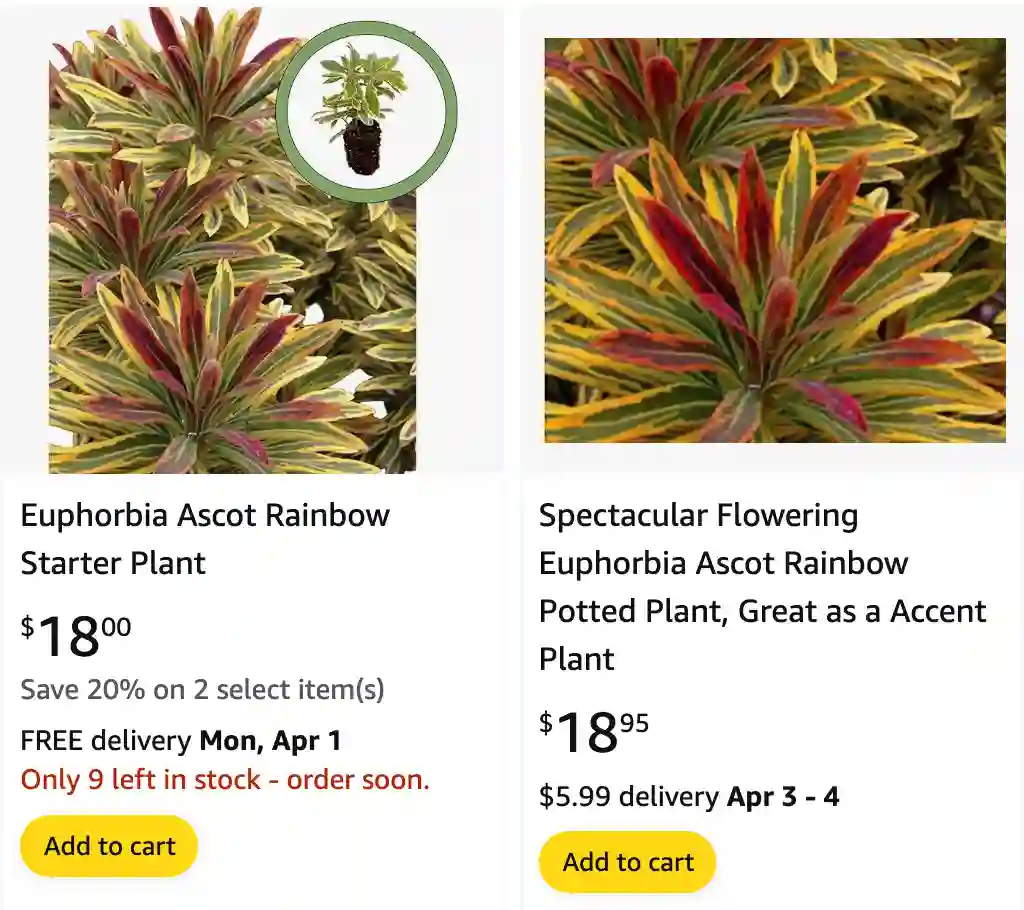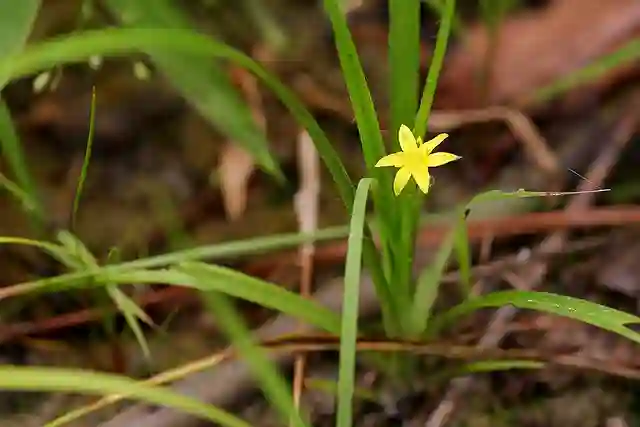
What color is the flower of a Euphorbia Ascot Rainbow?
The flowers of a Euphorbia Ascot Rainbow are quite distinctive and eye-catching. They start out with a creamy yellow color that gradually matures into a soft lime green. Sometimes, there are hints of pink or red in the flowers, especially in cooler weather, adding to their vibrant appearance.
2093 Species in Genus Euphorbia
How to prune Euphorbia Ascot Rainbow?
Pruning my Euphorbia Ascot Rainbow is an easy task. I usually wait until after the flowering period, around late spring to early summer. I carefully cut back the flowering stems down to the base. This not only keeps the plant looking neat but also encourages new growth for the next season.
Is Euphorbia Ascot Rainbow evergreen?
Yes, the Euphorbia Ascot Rainbow is an evergreen plant. I love how it maintains its variegated foliage throughout the year, providing continuous color and interest in my garden even during the winter months. Its leaves are a beautiful blend of green, yellow, and pink.
When to cut back Euphorbia Ascot Rainbow?
I cut back my Euphorbia Ascot Rainbow right after it finishes blooming, which is typically in late spring. This timing works best for me because it allows the plant to recover and produce new growth over the summer and fall, ensuring it’s ready to bloom again the next year.
Can Euphorbia Ascot Rainbow grow in Maryland?
Living in Maryland, I’ve found that the Euphorbia Ascot Rainbow can indeed thrive here. It does well in my garden as long as I ensure it’s planted in a spot with well-draining soil and receives plenty of sunlight. The plant is hardy enough to handle our weather fluctuations.
How long do Euphorbia Ascot Rainbow perennials bloom?
The Euphorbia Ascot Rainbow in my garden blooms from late spring through early summer. The blooming period can last several weeks, during which the plant is covered with its distinctive, colorful flowers. It’s always a highlight of my garden during this time.
How to propagate Euphorbia Ascot Rainbow?
Propagating Euphorbia Ascot Rainbow, also known as Euphorbia ‘Ascot Rainbow’, can be a bit trickier than some plants due to its milky sap, which can be an irritant. However, with proper care and following these steps, you can successfully increase your Euphorbia Ascot Rainbow collection. Here’s how:
Important Note: It’s important to be aware that Euphorbia ‘Ascot Rainbow’ is a patented variety. Propagating patented plants may not be legal for commercial purposes in your region. It’s best to check the regulations in your area before propagating this specific cultivar.
Here are the steps for propagating Euphorbia Ascot Rainbow through stem cuttings (assuming it’s for personal use):
Preparation:
- Gather Supplies: You’ll need sharp, sterilized pruning shears or a sharp knife, gloves, rubbing alcohol, and a well-draining potting mix suitable for cacti and succulents.
- Wear gloves: The milky sap of Euphorbia Ascot Rainbow can irritate skin and eyes. Wear gloves throughout the propagation process to protect yourself.
Taking Cuttings:
- Identify healthy stem: Choose a healthy, non-flowering stem for propagation. Avoid stems with any signs of disease or damage.
- Make the cut: Using your sterilized shears or knife, make a clean cut just below a leaf node (the bump where leaves emerge) at a 45-degree angle.
- Sap removal: The cut will release a white, milky sap. This sap can be irritating. Here’s how to handle it:
- Let it drip: Allow the milky sap to drip freely for a few minutes. You can dab the cut stem with a paper towel to encourage the sap to flow.
- Rinse (optional): Some growers recommend briefly rinsing the cut stem with clean water to remove excess sap. Be careful not to splash the sap or get it in your eyes.
- Air dry: Allow the cut end of the stem to air dry completely for several hours, or even overnight, until the cut surface seals over. This prevents moisture loss and infection.
Planting the Cuttings:
- Potting mix: Prepare a pot with a well-draining potting mix suitable for cacti and succulents. Moisten the potting mix slightly but ensure it’s not soggy.
- Planting: Make a hole in the potting mix slightly deeper than the length of the cut stem. Insert the dried cut end of the stem into the hole and gently firm the soil around the base to secure it.
- Watering: Avoid watering the cutting immediately. Overwatering can cause rot before the roots establish themselves.
Aftercare:
- Placement: Place the pot in a warm location with bright, indirect sunlight. Avoid harsh direct sunlight, especially during the hottest part of the day.
- Watering: Wait until the top inch or two of the soil feels completely dry before watering the cutting. Water thoroughly until excess water drains from the drainage holes. Avoid leaving the pot sitting in water.
- Rooting: Be patient, as rooting can take several weeks to a few months. Signs of successful rooting include new growth emerging from the top of the cutting.
Additional Tips:
- You can propagate Euphorbia Ascot Rainbow throughout the growing season, but spring and summer are generally considered the best times.
- While bottom heat is not essential, it can help to promote faster rooting. You can place the pot on a heat mat set to low temperature.
- If the cutting starts to rot or shrivel, it indicates a failed propagation attempt. Discard the cutting and try again with a fresh stem.
Where to plant Euphorbia Ascot Rainbow?
I’ve found the best place to plant my Euphorbia Ascot Rainbow is in a sunny spot with well-drained soil. It’s important to avoid areas that get waterlogged because the plant doesn’t like wet feet. A location that gets full sun or partial shade works perfectly.
Will a cut stem of Euphorbia Ascot Rainbow branch out?
When I cut a stem of Euphorbia Ascot Rainbow, it does branch out. After pruning, new shoots typically emerge from the base of the plant or from nodes along the stem. This branching out makes the plant bushier and more robust, which I think enhances its appearance in the garden.
If i die, water my plants!

